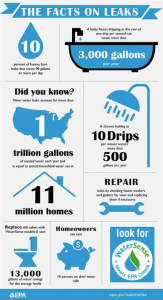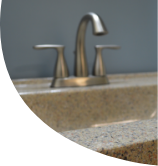My shower is leaking…NOW WHAT?!
 In the United States alone it is estimated that about 10% of homes have leaks that waste 90 gallons or more of water per day. That is 630 gallons a week or 32,850 gallons per year WASTED just at a single home! Why aren’t more people talking about this?! Seems like we could take a chunk out of this whole global warming issue if every homeowner took the time and energy to find and fix their leaks. But alas, probably due to their size these leaks go largely unnoticed and untreated; because it seems like it is only when they become more noticeable and damage other areas of the home that repairs are considered. So what can you, the homeowner, do to be proactive should you discover moisture leaking from your shower? Well, first and foremost it is important to understand that preventative maintenance and vigilance will help prevent costly repairs and water bills. So keeping an eye on your bathroom’s problem areas, which we will learn later, can help you catch an issue before it gets too big.
In the United States alone it is estimated that about 10% of homes have leaks that waste 90 gallons or more of water per day. That is 630 gallons a week or 32,850 gallons per year WASTED just at a single home! Why aren’t more people talking about this?! Seems like we could take a chunk out of this whole global warming issue if every homeowner took the time and energy to find and fix their leaks. But alas, probably due to their size these leaks go largely unnoticed and untreated; because it seems like it is only when they become more noticeable and damage other areas of the home that repairs are considered. So what can you, the homeowner, do to be proactive should you discover moisture leaking from your shower? Well, first and foremost it is important to understand that preventative maintenance and vigilance will help prevent costly repairs and water bills. So keeping an eye on your bathroom’s problem areas, which we will learn later, can help you catch an issue before it gets too big.
Next, try to identify the exact location of the leak; believe it or not “the shower” is a pretty general location for a leak. Take a look at your shower, you’ll notice that it has quite a few seams and other areas where water can escape and wreak havoc. To help combat that here are the three most common (or problem) areas that could be causing the trouble for you to inspect first…
Leaky Plumbing
Perhaps it isn’t the actual shower itself, but rather the plumbing attached to the shower that is faulty. If you do not possess this skill set then this would definitely be a project for a plumber to investigate and repair if necessary. When it comes to your pipes you will want a licensed professional who is equipped to handle a project of this magnitude. Skip Craig’s List or DIY YouTube videos for this one, this isn’t a job for the faint of heart.
***Side Note: Leaky faucets can cause corrosion to cast iron tubs and sinks. And in some cases rusted holes can create leakage through the tub or sink. If you suspect your tub or sink may be leaking due to rust read our blog: 3 Problems Resurfacing Can’t Fix.***
Faulty Caulking/Grout
The caulk and grout lines are often overlooked when considering the source of leaking water in showers. However, they are usually the culprit behind unwanted water travel to undesirable places in your home. Grout and caulking are designed to be replaced every so often (we recommend about 6 months to a year depending on use and moisture retention in the bathroom). So with age these being to fail, by separating from the wall and by loosing their ability to repel moisture. If you have a tile shower pan you need to be especially mindful of your grout so not only should you need to keep an eye on the grout lines in the pan but on the walls as well. Grout is tricky and a little more difficult to work with that is why we recommend contacting a company who specialized in re-grouting should you suspect faulty grout to be behind the cause of your leak. While caulking on the other hand is fairly easy to replace and can be done so by reading our step-by-step guide on re-caulking your shower.
Cracks
Cracks can occur in any shower for a number of reasons; whether it be from fiberglass flexing with structural pressure and age or from dropping something heavy on the tile. Whatever the cause, these cracks can leak water causing larger issues with time. If you notice any cracks, hairline or otherwise, in your shower be on the look out for rogue water. And it should go without saying that you should seal those cracks up at the first chance you get. Unfortunately, resurfacing is not a recommended fix for shower cracks since it is mostly a cosmetic solution (not a long term one meant for maintaining the structural integrity of the shower). At this point you might want to replace whatever is cracked, that being the shower pan or any broken tile.
So to recap for all of those TL;DR people out there…
- There are three main areas to investigate if you suspect your shower may be leaking water. And they are your plumbing, grout lines, and any hairline or stress cracks.
- You’ll want to investigate these leaks as soon as you notice something is wrong. Don’t drag your feet with this project!
- Waiting a while to address leaks cause cost you more time, money, and energy fixing the problem.
- Some causes of leaking are DIY while others are not, make sure you are completely comfortable tackling this project before starting.


